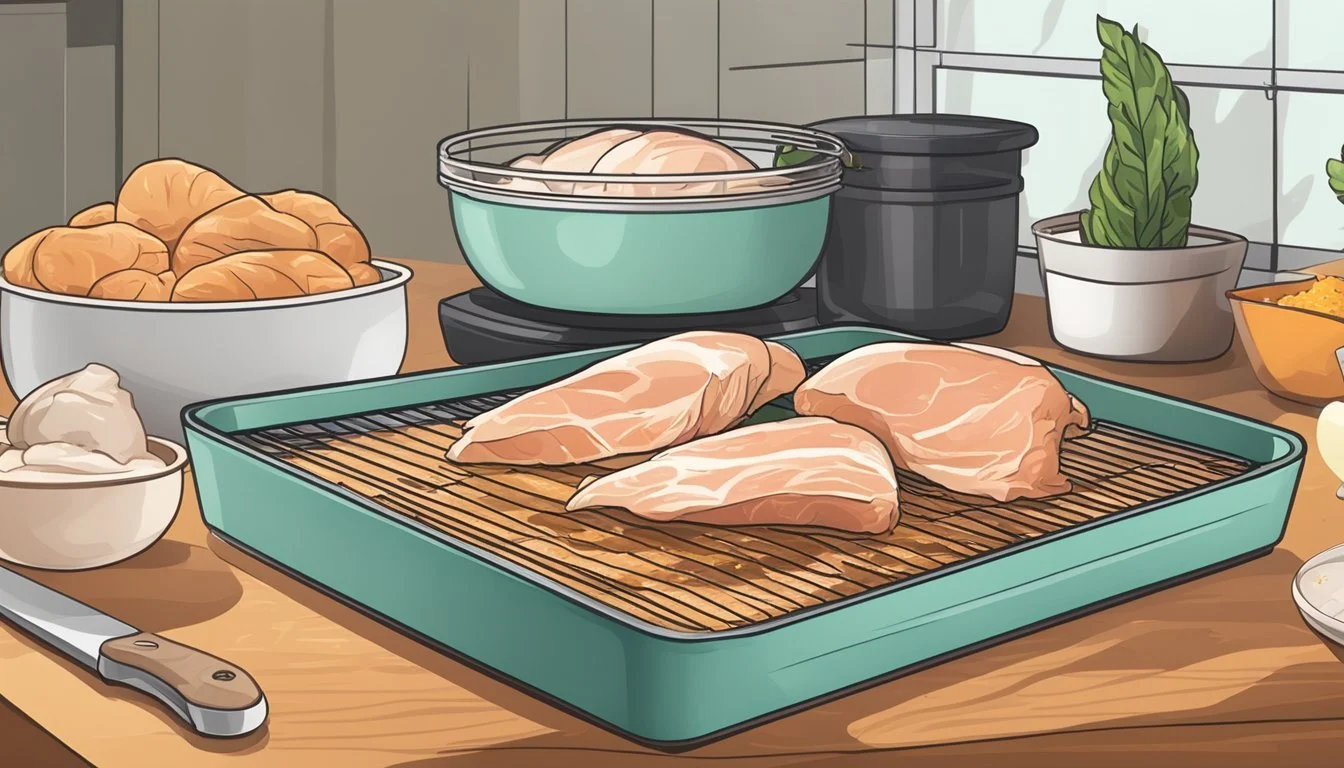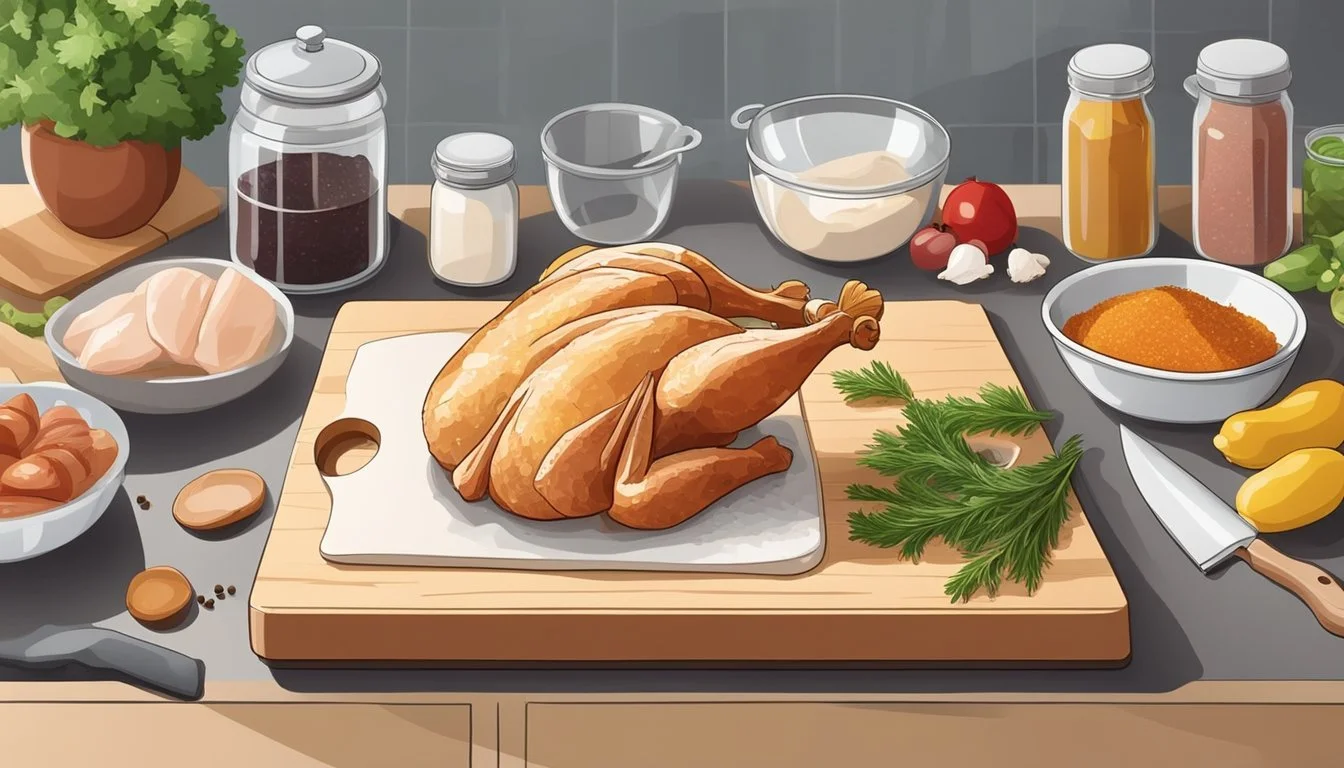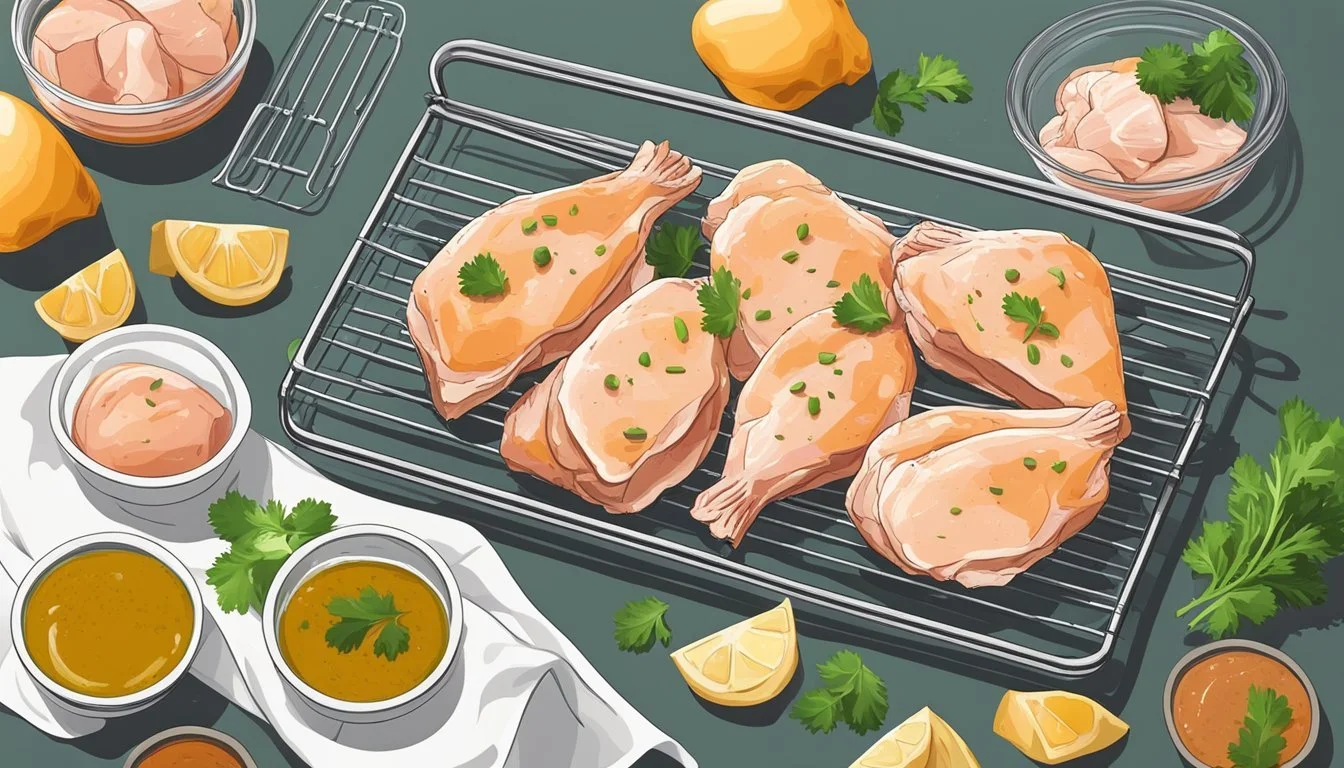Crafting Your Own Homemade Chicken Breast Jerky
Step-by-Step Guide to Delicious Snacks
Homemade chicken jerky offers a savory and protein-packed snack that can be customized to suit individual tastes. The process involves slicing chicken breasts into thin strips, marinating them to infuse flavors, and then drying the meat until it achieves the desired chewy texture that jerky is known for. Careful attention to technique and food safety ensures that the jerky is not only delicious but also safe to consume.
Creating chicken jerky at home allows for complete control over the ingredients used in the recipe, permitting a reduction in preservatives and additives often found in store-bought versions. The key to success lies in choosing high-quality chicken breasts, trimming any excess fat to prevent spoilage, and marinating the meat to create depth of flavor. This lean snack is ideal for those seeking a high-protein option and lends itself well to being stored for later enjoyment, making it a convenient choice for on-the-go snacking or nutritious fuel during outdoor activities.
Selecting Quality Chicken
The cornerstone of flavorful, high-quality homemade jerky is the selection and preparation of the chicken breast. Ensuring the chicken is of optimal quality and properly prepared will lead to better texture and taste of the final jerky product.
Choosing the Right Chicken Breast
Selecting the right chicken breast involves looking for boneless and skinless options that provide clean, lean cuts of meat. They should possess a uniform pink shade, indicating freshness and good quality. It is crucial to source from reputable providers, ensuring that the chicken has been consistently refrigerated and handled with care. One should consider:
Freshness: The chicken breasts should not exhibit any off odor, an indicator of spoilage.
Texture: They should feel firm to the touch and not slippery or slimy.
Appearance: High-quality chicken has a pink hue with no signs of discoloration or drying around the edges.
Preparing the Chicken Breast
Proper preparation of the chicken breast is essential for safe and tasty jerky. Start by trimming all visible fat; fat can cause the jerky to spoil faster due to its tendency to oxidize. The ideal thickness for slicing is between 1/8 and 1/4 inch; uniform slices will ensure consistent drying. Handling the chicken breast with clean equipment in a sanitized space is critical to minimize bacterial contamination. Following are the key preparation steps:
Trimming: Remove any residual skin and visible fat for a leaner end product.
Slicing: Use a sharp knife or meat slicer to achieve even thickness. Consistency is crucial for even drying.
Taking the time to select and prepare the chicken breast carefully will significantly contribute to the success of the homemade chicken jerky.
Creating the Marinade
The marinade not only infuses the chicken jerky with flavor but also tenderizes it, ensuring an optimal texture once dried. Precision in both the ingredients used and the techniques for mixing and marinating are integral for the perfect jerky.
Essential Ingredients
Soy sauce: Provides a rich, umami base for the marinade.
Worcestershire sauce: Adds complexity and depth of flavor.
Apple cider vinegar: Offers a tart contrast enhancing the overall taste.
Honey: A touch of sweetness that balances the savory elements.
Garlic powder and fresh garlic: Both ensure a robust garlic profile.
Black pepper: Introduces a warm, spicy note.
Liquid smoke: For that desirable smoky taste.
Ginger: Brings a zesty, fresh undertone.
Chili garlic sauce: Adds a kick of heat for those who prefer a spicy tang.
Spices: Additional spices can be added for customization.
Mixing and Marinating Techniques
They should select a large bowl to combine the liquid ingredients, which include soy sauce, Worcestershire sauce, apple cider vinegar, honey, and if preferred, liquid smoke. To this liquid mixture, they should stir in the dry components—garlic powder, black pepper, and any additional spices desired. Fresh minced garlic and ginger lend a fresher burst of flavor and should be integrated thoroughly.
After mixing, they can introduce thinly sliced chicken breast to the bowl, ensuring each strip is evenly coated with the marinade. Alternatively, the mixture can be poured into a ziplock bag with the chicken strips, which makes it easier to coat the strips and is efficient for storage in the refrigerator. Marinating should ideally last between 6 to 24 hours; this duration allows the chicken to absorb the flavors entirely. It's critical to turn the bag or stir the mixture occasionally to guarantee an even flavor distribution.
Drying the Chicken Jerky
The drying process is integral to creating safe and flavorful chicken jerky. Two main methods are popular: using a dehydrator or an oven. Each method requires attention to temperature settings and proper arrangement on drying racks for optimal results.
Dehydrator vs Oven Method
A dehydrator is specifically designed for drying foods and often yields consistent results due to regulated airflow and temperature control. Conversely, an oven can also be utilized, especially if a food dehydrator is not available. Using an oven, one must place the jerky on a wire rack over a baking sheet to allow for proper air circulation.
Method Equipment Needed Airflow Dehydrator Food dehydrator, Dehydrator trays Built-in; designed for even drying Oven Oven, Baking sheet, Wire rack Achieved via wire rack placement
Setting the Proper Temperature
Whether using a dehydrator or an oven, ensuring the proper temperature is critical for safety and to avoid over-drying. Dehydrators should be set around 160 degrees Fahrenheit. For ovens, the temperature should be slightly higher—to compensate for the less consistent heat—up to 165-200 degrees Fahrenheit.
Method Temperature Dehydrator 160°F Oven 165°F - 200°F
Arranging Chicken on Drying Racks
To ensure thorough drying, chicken strips should be arranged in a single layer with no overlapping pieces on the drying racks or dehydrator trays. The thickness of the chicken can affect drying time—thinner slices will dry faster than thicker ones. Regular checking is recommended to prevent over-drying. Once dried, the jerky should be stored in an airtight container to maintain freshness.
For a dehydrator: Place chicken evenly on trays.
For an oven: Set chicken on a wire rack in a single layer over a baking sheet.
By closely managing these aspects of the drying process, one can craft high-quality homemade chicken breast jerky that is both safe and delicious.
Safety and Preservation
When making homemade chicken breast jerky, ensuring food safety during preparation and optimizing storage for extended shelf life are paramount. These steps prevent bacterial growth and maintain the jerky's quality.
Ensuring Food Safety
Chicken jerky requires careful handling to ensure it is safe to eat. The process starts with reaching an internal temperature high enough to kill any bacteria. Therefore, the chicken should be heated to 275°F (135°C) for 10 minutes before or after dehydration.
Post-heat treatment steps:
Preheat oven to 275°F.
Place dried jerky on a baking sheet for at least 10 minutes.
Marinating the chicken is not just for flavor; it can also include acidic components that inhibit bacteria. However, the chicken must be marinated in the refrigerator—never at room temperature—to prevent bacterial growth.
Storing for Maximum Shelf Life
After dehydration, proper storage is critical for maintaining the jerky's quality and shelf life. It should be stored in an airtight container to prevent exposure to air and moisture, which can lead to spoilage.
Short-term storage:
Place the jerky in a clean, airtight container.
Refrigerate to extend freshness, particularly if it will be consumed quickly.
Long-term storage:
For the longest shelf life, freeze the jerky.
Use freezer-safe bags or containers for storage.
Clearly label the container with the freezing date.
By following these guidelines, one can enjoy homemade chicken breast jerky that is both safe to consume and poised to maintain its taste and quality over time.
Flavoring and Texture
Perfecting the flavor and texture of homemade chicken breast jerky hinges on meticulous seasoning and careful preparation. One must balance the robustness of flavors with the desired chewiness to achieve a superior jerk.
Variety of Flavor Profiles
To cater to diverse palates, one can experiment with a wide range of flavor profiles. A basic recipe may begin with a concoction of soy sauce, Worcestershire sauce, and honey. To this foundation, various spices and seasonings can be added for complexity:
Savory: Onion powder, garlic powder, and black pepper are staples.
Smoky: Smoked paprika and liquid smoke infuse a barbecue essence.
Heat: A pinch of cayenne pepper will introduce a spicy kick.
The use of herbs such as thyme or rosemary can further refine the jerky's flavor.
Achieving Desired Texture
The texture of chicken breast jerky should be chewy but not tough. Thickness and drying time are pivotal:
Thickness: Strips should be cut uniformly, ideally 1/4 inch thick.
Drying: Even dehydration is crucial. Using a dehydrator or an oven on a low setting aids in achieving the optimal chew.
Marinating the chicken for several hours will not only deepen the flavor but also tenderize the meat, enhancing the texture.
Serving and Usage Ideas
Homemade chicken breast jerky serves as a satisfying and protein-rich snack that can be enjoyed in various ways. It is crafted to be low in fat yet high in essential nutrients, providing a healthy option for those on the go.
Incorporating Into Meals
Chicken breast jerky, with its high protein content, can serve as a flavorful addition to many meals. One can:
Chop it up: Add small pieces to salads for a protein-packed crunch.
Stir into dishes: Mix strips into stir-fries or omelets to enrich them with protein.
Healthy Snacking
As a snack, chicken jerky is both healthy and wholesome. Convenient characteristics include:
Portability: Its dry and lightweight nature makes it easy to carry in a small container or zip-lock bag.
Nutrition: A few pieces can provide a substantial protein boost, ideal for midday snacking or post-workout recovery.
Chicken breast jerky, when made at home, ensures control over ingredients, offering a low-fat, nutrient-dense option that satisfies hunger and supports a balanced diet.
Comparing Chicken Jerky with Other Meats
When exploring the world of jerky, one will find that chicken, beef, and turkey jerky each offer distinct nutritional profiles and taste experiences. Making an informed choice requires understanding these differences.
Chicken vs Beef Jerky
Chicken jerky and beef jerky diverge primarily in their fat content and flavor. Chicken jerky typically has a lower saturated fat level compared to beef jerky, making it a preferable option for those monitoring their intake of this type of fat. On average, a serving size of chicken jerky contains about 1g of saturated fat, whereas beef jerky might have up to 3g. Chicken jerky is also generally lower in cholesterol — for individuals managing their cholesterol levels, chicken jerky might be the wiser choice.
As for flavor, beef jerky is known for its robust taste, often described as richer and more intense. The texture of beef jerky is also different; it can be tougher and chewier than chicken jerky. Chicken jerky, on the other hand, has a milder, often slightly sweeter taste and a tender texture that may appeal to those wanting a softer chew.
Chicken vs Turkey Jerky
Turkey jerky and chicken jerky share more similarities than when either is compared to beef due to their poultry origins. Both are lower in saturated fat than beef jerky, with turkey jerky often presenting a slightly higher saturated fat content than chicken jerky, although the difference is not usually significant.
In terms of fiber content, neither chicken nor turkey jerky contain this nutrient, as fiber is absent in animal proteins. Comparing the two in terms of flavor, turkey jerky can have a gamier taste, while chicken jerky typically presents a neutral flavor, serving as a versatile canvas for a variety of marinades and spices. The texture of turkey jerky can be a bit tougher than chicken jerky, providing a chewy experience similar to that of beef jerky.
Helpful Tips and Tricks
Crafting homemade chicken jerky involves precision in slicing and an understanding of flavor preferences through marinades. These factors are pivotal in creating a palatable and safe-to-eat jerky.
Slicing and Cutting Techniques
For a consistent cure and dehydrating process, slicing the chicken breast evenly is crucial. One should ensure the use of a sharp knife or a meat slicer to obtain uniform thin strips, ideally between 1/8-1/4 inch thick. The chicken can be partially frozen to make this task easier, as it provides a firmer texture, facilitating smoother cuts and reducing the risk of shredding the meat. One should always aim for tender cuts, free of visible fats to improve the curing process and the final texture of the jerky.
Before placing the chicken strips onto dehydrator trays or a baking sheet, it's recommended to pat them dry with paper towels to remove excess moisture. If using an oven, lining the baking sheet with parchment paper can aid in easy cleanup and prevent sticking.
Marinades and Taste Preferences
Marinades not only enhance the flavor but also play a part in the safety of the chicken jerky. An individual can experiment with various ingredients to cater to their taste preferences. However, incorporating curing salt is advised as it inhibits bacterial growth during the dehydration process.
When preparing a marinade:
Combine all desired ingredients thoroughly in a bowl.
Place the chicken strips in a resealable bag or bowl and pour the marinade over them, ensuring all pieces are entirely coated.
For optimal flavor infusion, marinate in the refrigerator for at least 6 hours and no more than 24 hours.
By following these particular techniques and guidelines, one increases their chances of achieving flavorful, tender jerky every time.
Troubleshooting Common Issues
In making chicken jerky, one may encounter issues with dehydration or storage that can affect quality and safety. Understanding these challenges ensures a successful jerky-making endeavor.
Dehydration Challenges
When dehydration is incomplete or uneven, chicken jerky may be unsafe to eat or have a poor texture. A dehydrator is the optimal tool, offering even airflow and consistent temperature control. If the jerky is too soft or too moist, it may need more time. One should ensure the dehydrator is set to 165 degrees Fahrenheit and that the meat is laid out in a single layer without overlapping.
Temperature Irregularities:
Check dehydrator temperature settings. The temperature should remain steady.
Avoid opening the dehydrator frequently, which can cause temperature fluctuations.
Air Flow Disruption:
Ensure that each tray allows for ample air circulation.
Rearrange trays periodically during the dehydration process to promote even drying.
Storage and Spoilage Problems
After dehydration, proper storage is essential to prevent spoilage. Without preservatives, homemade jerky has a shorter shelf life and must be stored carefully. If the jerky feels sticky or smells off, it may indicate the beginning of spoilage. For long-term storage, use a freezer where the jerky can last for several months. For short-term storage, keep it in a cool, dry place or refrigerate it in a resealable bag.
Room Temperature Storage:
Keep jerky in a cool, dry place away from direct sunlight, preferably in a pantry.
Use resealable bags with as much air removed as possible to minimize exposure to moisture and contaminants.
Refrigeration and Freezing:
Refrigerated jerky in an airtight container can last up to two weeks.
For freezing, wrap jerky in foil or plastic wrap before placing it in a resealable bag, preventing freezer burn and saving space.
By following these guidelines and being attentive to details, one can enjoy safe and delicious home-crafted chicken jerky.
Conclusion
Homemade chicken jerky offers an exceptional opportunity to create a satisfying and flavorful snack tailored to individual taste preferences. Utilizing quality chicken is paramount; it ensures not only safety but also contributes to the overall taste and texture of the end product. When preparing this savory treat, chefs should select a marinade that complements their flavor profile of choice. A well-formulated marinade can profoundly enhance the jerky's flavor, imbuing the chicken with a rich and distinct taste.
The process of making jerky requires careful attention and precision. One must consistently monitor dehydration times and temperatures to ensure the chicken dries adequately without overcooking. Once correctly dehydrated, the jerky should exhibit a perfect balance between chewiness and tenderness. Those who master the technique can enjoy a high-protein snack that is both healthy and homemade.
In summary, to ensure a successful outcome, one should:
Choose quality chicken: Lean meats typically yield the best results.
Craft a flavorful marinade: Strike a balance between savory, sweet, or spicy elements according to one's liking.
Dehydrate with care: Follow safe temperature guidelines while optimizing drying time for the desired texture.
Store properly: To maintain freshness, keep the jerky in airtight containers.
By adhering to these points, enthusiasts can produce homemade chicken jerky that is both appetizing and rewarding to make.







